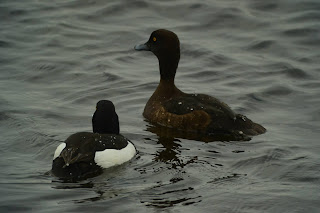Birding the candle at both ends is a continuing theme through the spring and following last years brief Nightjar residency at Chippenham Fen it was always going to be worth a couple of dusk strolls. I met Mark H and took a saunter into the damp, open woodland. A Woodcock grunted a welcome as it ploughed it's aerial furrow and the evening chorus was underpinned with the reeling of Grasshopper Warblers. A flyover Curlew was notable but tonight there was no mechanical churring or visit from a Nightjar.
We headed over to Wicken Fen and enjoyed trying to work out the physics of Grasshopper Warbler song, particularly more distant birds. Two conundrums present themselves - firstly reeling Grasshopper Warblers are easier to hear when walking but the song often then disappears when you stop to listen, secondly reeling can often be heard with one ear but ear cupping with both ears can effectively eliminate the sound from hearing. Something to do with Doppler I think and then Schroedinger I imagine.
And to imagination it all then went.......
Nearing the end of the Bakers Fen bank, well past midnight, we dawdled, reminiscing about the Marsh Warbler we'd found there singing it's heart out last spring. We'd also been talking about upcoming pelagics and seawatching in the south west - all booked for the summer. I had definitely zoned out and was thinking about Pteradroma's when I heard, clearly but absent mindedly, the very call I had been listening to on Xeno Canto with frequency, over the past month. Like some mad head I asked Mark if he'd heard the bonkers giggle of Little Crake. He hadn't and I immediately questioned if I had actually daydreamed the sound, a silent minute or two. I decided it must have been a short phrase of Sedge Warbler but then it called again and it still sounded exactly as a female Little Crake should. Mark hadn't heard it but now I knew I wasn't in fanciful territory, well there was a thing out there making a noise - the idea that it was a Little Crake still admittedly on the fanciful side. Another silent vigil and there again - Mark heard it this time and a little shocked we both agreed that it did sound exactly like a Little Crake. It was late and we knew that into the night these particular Crakes become very quiet so we were not surprised, after another half hour of listening, that we didn't hear the bird again. What to do........
Following the nocturnal Broad Billed Sandpiper that got away, I am now experimenting with continuously recording audio when out birding. The Crake was a subtle call not easy to pick up so I didn't expect that the recording would be much use. I was heading to Yorkshire with the family early next morning but I did grab some time to check the recording on Audacity. Once I'd located the dialogue I listened for the Crake, nothing first time but when I cranked up the volume - boom - there was the giggle. I sent the Birdo brethren the audio and we rang just a couple of people who could verify the record if it were to call again that night - which indeed it did and all seemed happy with the identification so the news has gone out. All a bit crazy really but very, very rewarding.
Post Script - for several nights it was heard intermittently and then a germ of doubt quickly led to a re-identification of the call as a snippet of nocturnal Shelduck song. A new ID pitfall for calling female Little Crake (that also removed a 2021 Yorkshire record) - in theory it's great to add to the ornithological knowledge base but I'd have preferred not to feel the pangs of disappointment that lasted several days.



















